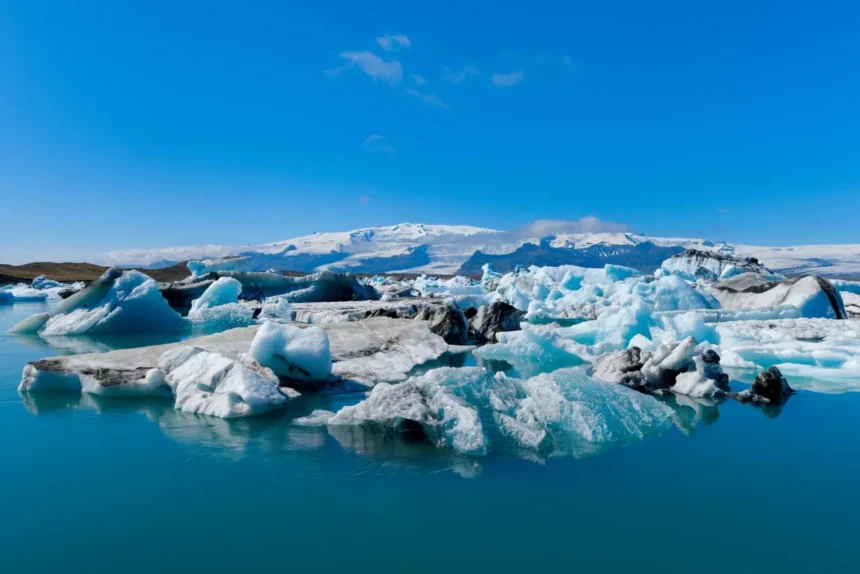⫸ Introduction to Glacial Lagoon of Iceland
Glacial lagoons are mesmerizing bodies of water formed at the edge of retreating glaciers. As a glacier melts, massive chunks of ice break off, creating vast lakes filled with hauntingly beautiful icebergs. Iceland boasts some of the world’s most spectacular glacial lagoons, with Jökulsárlón Glacier Lagoon reigning supreme.
Jökulsárlón Glacier Lagoon of Iceland, lies nestled at the base of the mighty Vatnajökull glacier. Its brilliant blue waters, dotted with towering icebergs in fantastical shapes, create an otherworldly landscape. This breathtaking wonder holds ecological importance as a unique habitat teeming with life. It’s no surprise that Jökulsárlón Glacier Lagoon has become a symbol of Iceland’s raw, natural beauty.
⫸ Formation of Jökulsárlón Glacier Lagoon
Iceland’s Jökulsárlón Glacier Lagoon exemplifies the dynamic forces shaping our planet. Let’s dive into how this awe-inspiring natural wonder came to be:
The Power of Glaciers
Glaciers are not simply static masses of ice. They form over centuries as snow accumulates, compacts, and turns into dense ice. This immense weight triggers a slow, relentless flow – like an incredibly viscous river of ice carving through the landscape.
Glacial Retreat and Lagoon Birth
The Source: Breiðamerkurjökull Glacier
Jökulsárlón Glacier Lagoon owes its existence to the Breiðamerkurjökull Glacier, an outlet tongue of the vast Vatnajökull ice cap. As temperatures rose, Breiðamerkurjökull began retreating, leaving a basin filled with meltwater. This marked the birth of the iconic Glacial Lagoon in Iceland.
A Lake in Constant Evolution
Jökulsárlón Glacier Lagoon is a work in progress. The continuous calving of ice from Breiðamerkurjökull adds ever-new icebergs to the lake. Meanwhile, the lagoon flows into the ocean, shrinking and reshaping these bergs before they drift to sea. This dynamic dance with nature ensures the lagoon’s ever-changing size and appearance.
⫸ The Dynamic Ecosystem of Jökulsárlón Lagoon
Jökulsárlón Glacier Lagoon, a shimmering jewel in Iceland’s natural crown, supports a surprisingly vibrant ecosystem. This otherworldly environment, shaped by the interplay of ice, freshwater, and ocean currents, provides a unique habitat for a surprising array of life.
Wildlife of Jökulsárlón: Seals, Birds, and Marine Life
Seals are perhaps the most iconic residents of the Glacial Lagoon of Iceland. Their sleek forms are often seen bobbing amongst the icebergs or basking on chunks of ice. Several species, including harbor and grey seals, find food and shelter in the lagoon.
Bird enthusiasts will find delight in the diverse birdlife. Arctic terns, skuas, and gulls make this lagoon their home, while other species frequent the area during migration. Fish species like herring, capelin, and krill thrive in the cold water, forming an essential base of the food chain.
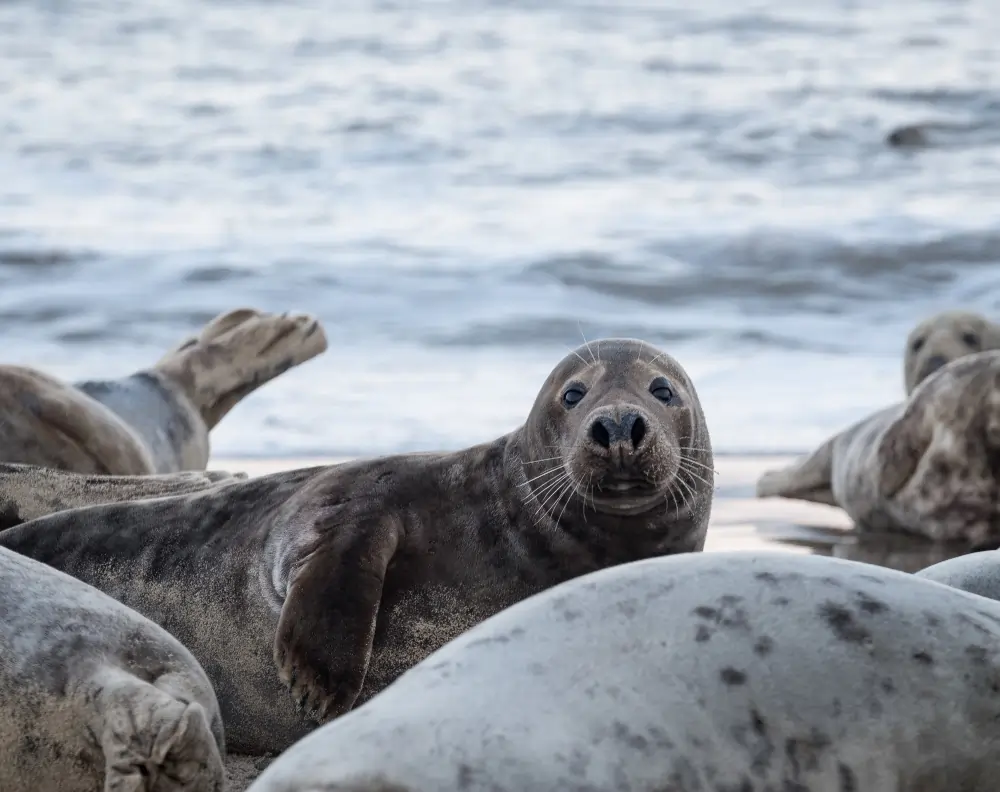
The Role of the Lagoon in the Glacial Ecosystem
Glacial lagoons like Jökulsárlón serve a vital function within the larger glacial ecosystem. They act as a buffer zone where the glacier’s meltwater meets and mixes with the ocean. This transition area creates a distinctive environment with unique characteristics that influence the life found within.
● Balance of Fresh and Saltwater
How the Unique Mix of Water Impacts the Ecosystem
The blend of saltwater from the ocean and freshwater from the melting glacier creates a brackish environment. This salinity gradient supports a range of organisms adapted to different salt concentrations. The influx of nutrient-rich freshwater also promotes the growth of phytoplankton, the foundation of the lagoon’s food web.
● Icebergs as Floating Habitats
The Role of Icebergs in the Lagoon’s Food Chain
The majestic icebergs within the Glacial Lagoon Iceland, aren’t merely decorative. They serve as floating ecosystems themselves. Algae can grow on the underwater portions of icebergs, attracting small creatures like krill. These krill, in turn, become fish food, which attracts larger predators like seals and birds. Thus, the icebergs play a vital role in the lagoon’s delicate food chain.
⫸ Experiencing the Wonders of Jökulsárlón (glacial lagoon of Iceland)
Jökulsárlón glacier lagoon, a dazzling crown jewel of Iceland’s south coast, offers a mesmerizing spectacle unlike any other. Here, colossal icebergs calved from the mighty Breiðamerkurjökull glacier drift serenely across the glacial lagoon, creating an otherworldly landscape that has captivated hearts and inspired photographers for decades.
But the wonders of Jökulsárlón extend far beyond the icy giants themselves. This is a place where adventure beckons, where the play of light paints the icebergs in a kaleidoscope of colors, and where the forces of nature collide in a breathtaking display. Let’s dive into the unforgettable experiences that await you at Jökulsárlón, Iceland’s Glacial Lagoon.
Boat Tours in glacial lagoon of Iceland: Zodiac vs. Amphibian
Getting up close and personal with the icebergs is a must for any visitor to Jökulsárlón. Two main types of boat tours are available: zodiac and amphibian.
Zodiac Tours: For the thrill-seeker, a zodiac boat tour provides an exhilarating way to navigate the glacial lagoon. These small, maneuverable crafts allow you to get right up next to the icebergs, offering unparalleled views and a chance to experience the lagoon from a unique perspective. Zodiac tours tend to be faster-paced, offering a more adventurous experience. Dress warmly and be prepared to get a little wet, as spray from the glacial lagoon can be refreshing on a sunny day!
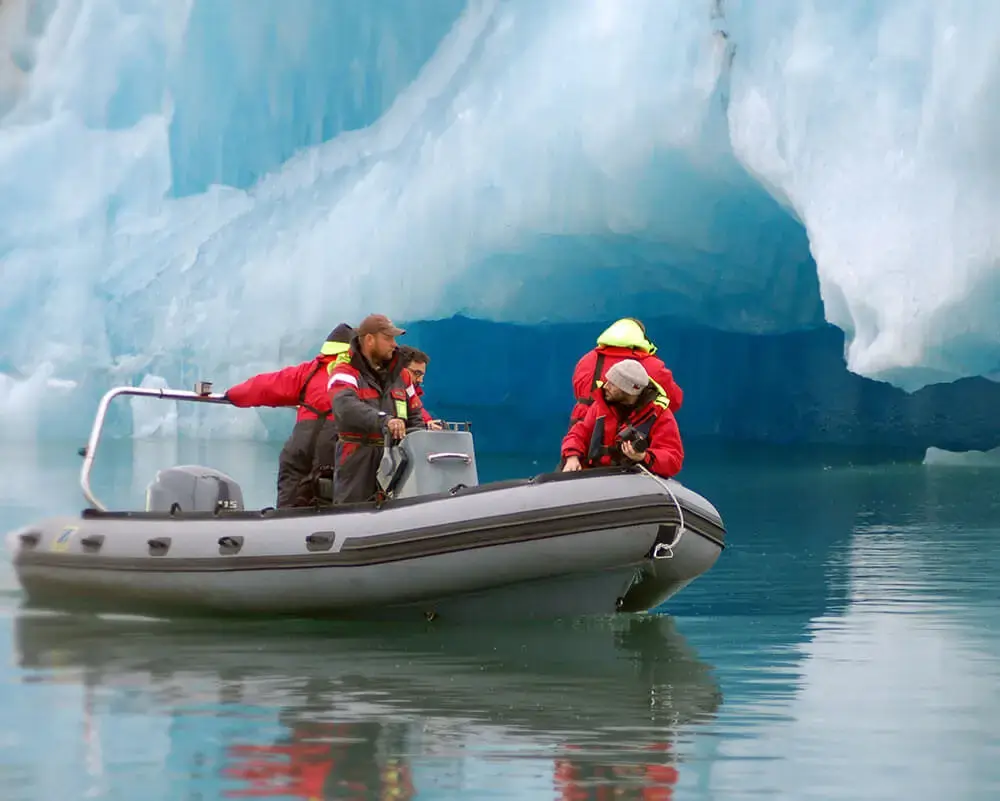
Amphibian Boat Tours: Opt for an amphibian boat tour for a more relaxed and comfortable exploration. These larger vessels provide a stable platform for viewing the lagoon and offer shelter from the elements. Amphibian tours are a great option for families with young children or those who prefer a more leisurely experience. They typically offer a more comprehensive tour, including commentary on the lagoon’s formation, wildlife, and unique ecosystem.
Finding the right tour for you depends on your personal preferences and priorities. Consider your desired level of adventure, comfort, and budget when making your choice. Both zodiac and amphibian tours offer an unforgettable way to experience the majesty of Jökulsárlón’s glacial lagoon.
Diamond Beach: Where the Ice Meets the Sea
Jökulsárlón’s icy giants don’t stay confined to the lagoon forever. Many eventually make their way to the nearby shore, where they are deposited on a black sand beach by the waves. This is Diamond Beach, a mesmerizing and slightly surreal landscape where glistening icebergs lie scattered like giant jewels against the stark volcanic sand. The contrast between the black sand, the turquoise waters of the Atlantic Ocean, and the dazzling white and blue icebergs is truly breathtaking.
Diamond Beach is a photographer’s paradise. The ever-changing light throughout the day creates a stunning array of photo opportunities. Early morning and evening light tends to bathe the icebergs in warm hues of orange and pink, while midday offers dramatic contrasts between the bright ice and the dark sand. No matter when you visit, Diamond Beach is sure to leave you spellbound.
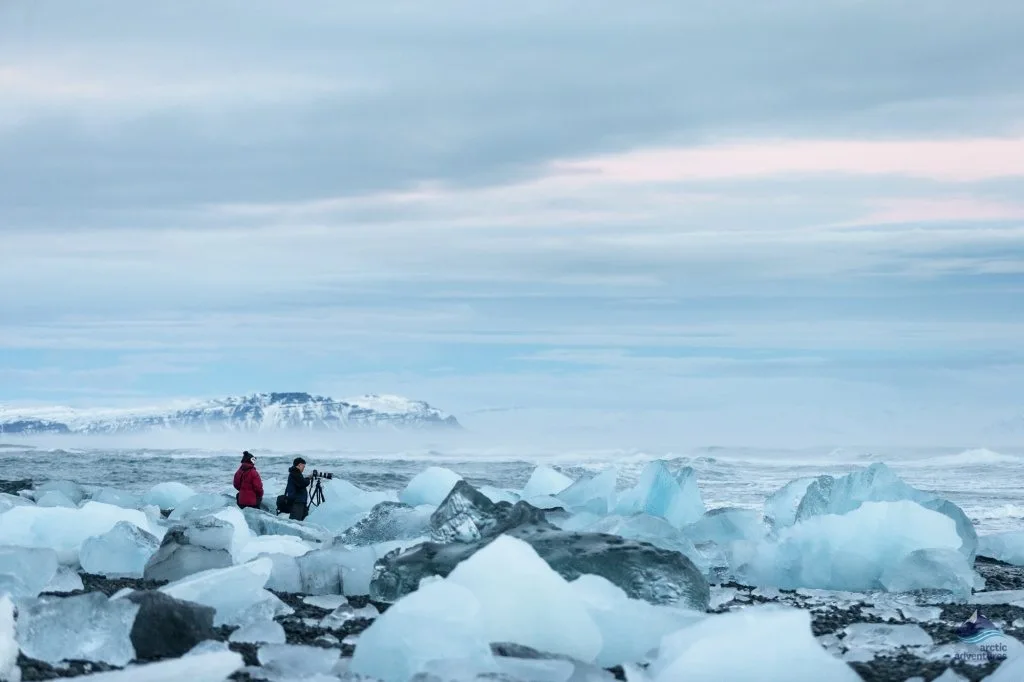
● Here are some photography tips for capturing the lagoon's beauty
- Use a polarizing filter to reduce glare and enhance the color saturation of the icebergs.
- Experiment with different shutter speeds to capture the movement of the water or create a sense of motion with the icebergs.
- Use a tripod for sharp images, especially when shooting in low-light conditions.
- Be mindful of the composition and leading lines in your photos. The icebergs themselves can create strong leading lines that draw the viewer’s eye into the image.
Diamond Beach is freely accessible year-round, making it a must-visit for any traveler to Jökulsárlón. Just dress warmly and watch out for sneaker waves, especially during high tide.
Northern Lights Viewing Opportunities (seasonal)
Jökulsárlón’s remote location and lack of light pollution make it a prime spot for viewing the Northern Lights, also known as the Aurora Borealis. This dazzling natural light display is caused by collisions between charged particles from the sun’s magnetosphere and atoms in the Earth’s atmosphere. The result is a mesmerizing spectacle of ever-shifting curtains of light dancing across the night sky.
The Northern Lights are most visible from late September to mid-April when there are more hours of darkness. However, even during these months, sightings are not guaranteed and depend on weather conditions. A clear sky with little to no cloud cover is essential for optimal viewing.
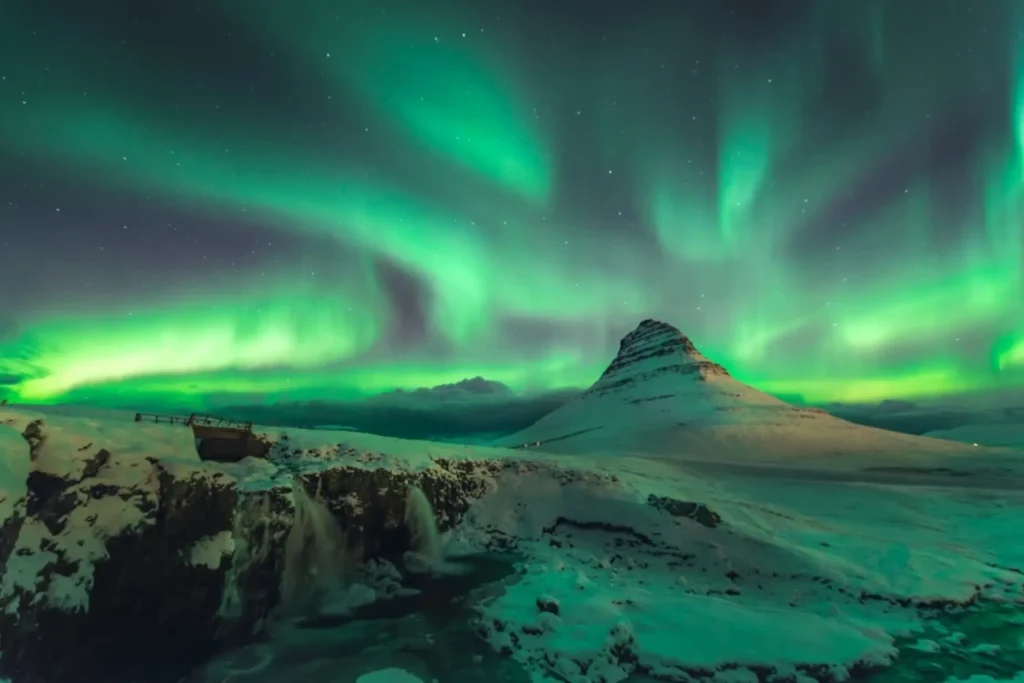
⫸ The Impact of Climate Change
The glacial lagoon of Iceland, while breathtaking evidence of nature’s beauty, also serves as a stark reminder of the pressing reality of climate change. Let’s dive into the ways this iconic landmark is transforming due to a warming world:
Retreating glaciers and the lagoon's expansion
The very existence of Jökulsárlón is a product of climate change. As temperatures rise, the mighty Breiðamerkurjökull glacier, a tongue of the vast Vatnajökull ice cap, has retreated significantly. The glacier’s meltwater forms the ever-expanding glacial lagoon of Iceland. This phenomenon is not unique to Jökulsárlón, as glacial retreat impacts glacial lagoons worldwide.
The fragility of Iceland's glacial environment
Iceland’s glaciers are particularly vulnerable to climate change due to their proximity to warmer ocean currents. This accelerated melting disrupts delicate ecosystems. The balance of fresh and saltwater in the glacial lagoon of Iceland shifts, potentially impacting the unique wildlife that calls it home.
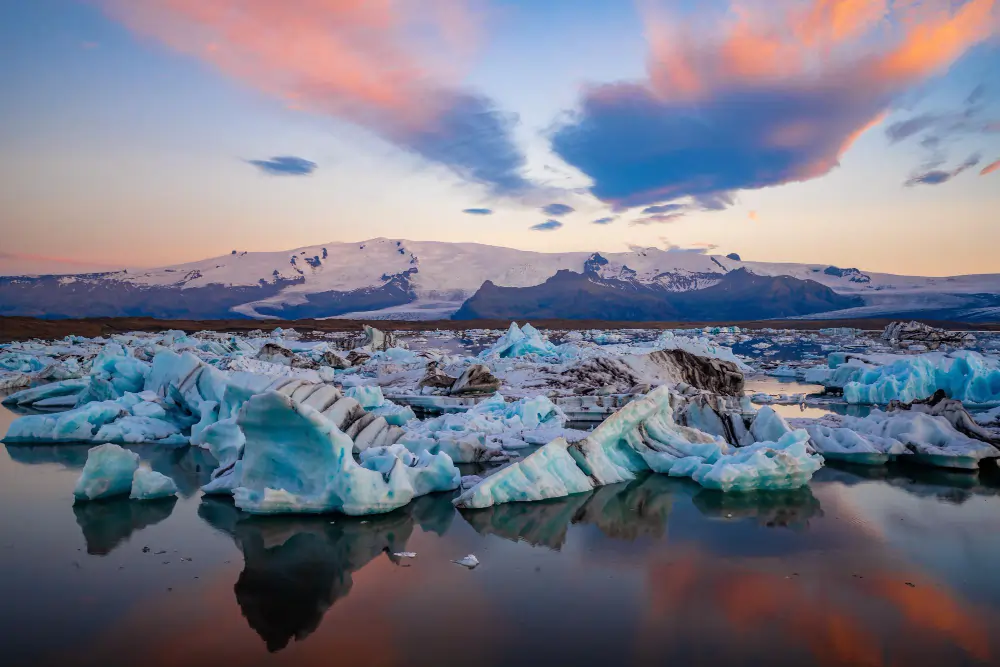
Sustainable tourism practices
Witnessing the impact of climate change firsthand at the glacial lagoon of Iceland underscores the importance of sustainable tourism. It is crucial to opt for tour providers with eco-conscious practices, minimize one’s carbon footprint, and respect the fragile environment. By being responsible travelers, we can help protect these natural wonders for future generations.
⫸ Planning Your Visit to Jökulsárlón
Planning a trip to the mesmerizing glacial lagoon of Iceland is an exciting adventure! To make the most of your experience, consider these essential factors to ensure a smooth and memorable journey.
The Best Time of Year to Visit
- Summer (June-August): Enjoy warmer temperatures and the midnight sun. Expect more crowds but longer daylight hours for exploration.
- Winter (November-March): Witness the lagoon under the magical Northern Lights (if you’re lucky!). Dress warmly as temperatures drop significantly.
- Shoulder Seasons (April-May, September-October): A balance of fewer crowds and decent weather.
How to Get There: Driving vs. Tours
- Driving: Rent a car in Reykjavik for ultimate flexibility. The drive along the scenic Ring Road is approximately 5 hours.
- Tours: Book a guided tour from Reykjavik or nearby towns like Vik. This option is excellent if you prefer a hassle-free experience with expert insights.
Accommodation Options Near the Lagoon
- Hotels: Several hotels near Jökulsárlón offer a range of comfort levels. Book early for peak season stays.
- Guesthouses: Experience local charm with cozy guesthouses in the surrounding areas.
- Camping: Adventurous travelers can camp near the lagoon for budget-friendly stays with stunning views.
Packing Essentials for the Icelandic Weather
- Layers: Iceland’s weather is unpredictable. Pack thermal base layers, fleece, waterproof jacket & pants.
- Warm accessories: Hats, gloves, and scarves are a must year-round.
- Hiking boots: Sturdy, waterproof boots if you plan on glacier hikes.
- Camera: Capture the incredible scenery!
⫸ Conclusion
From their awe-inspiring origins to their profound impact on the environment, glacial lagoons like Jökulsárlón in Iceland are breathtaking reminders of our world’s ever-changing landscapes. Let’s explore why these natural wonders leave a lasting impression.
Jökulsárlón – A Symbol of Nature's Power
Jökulsárlón embodies nature’s raw, transformative power. Witnessing the birth of icebergs, the sculpting of the lagoon, and the interplay of elements speaks volumes about the Earth’s dynamic forces. It’s a humbling experience that reminds us of our place within the grand scheme of the planet.
Why Jökulsárlón Leaves a Lasting Impression
The glacial lagoon of Iceland leaves visitors with feelings far beyond its initial beauty. It sparks curiosity about geology, concern for climate change, and an appreciation for the delicate balance of ecosystems. Jökulsárlón transcends the role of a scenic destination; it becomes a catalyst for contemplation, leaving a mark on our understanding of our world.

